#st martin
Text
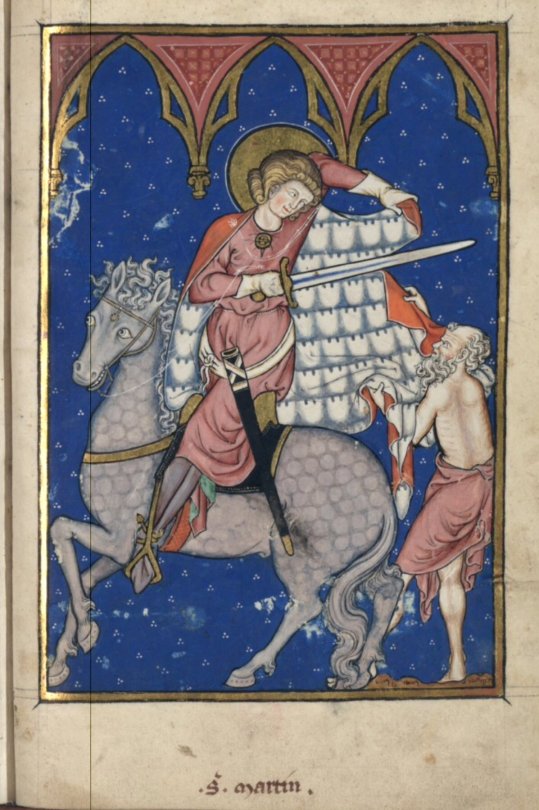
Today (Nov. 11th) is Martinmas, the feast of St Martin of Tours, an important festival in medieval Europe on the very cusp of winter.
A 4th century Pannonian (present day Hungary) soldier, Martin's conversion to Christianity led him to give up his life in the Roman army. As Bishop of Tours he founded the famous abbey of Marmoutiers. Well known for his charity, here St. Martin is depicted cutting his cloak in half to share with a beggar.
Today he is venerated in the church as the patron saint of the poor, soldiers and conscientious objectors.
(Source: BnF NAF 16251: Images de la vie du Christ et des saints. 13th century (c. 1280-1290); f.89r)
163 notes
·
View notes
Text

St Martin and the Beggar by Alfred Rethel
#st martin#saint martin#beggar#art#alfred rethel#cloak#gaul#france#chivalry#roman#cavalry#soldier#knight#knights#christianity#christian#medieval#middle ages#martin of tours#mediaeval#history#europe#european#religion#religious art#white horse#white steed#armour#horse#roman empire
63 notes
·
View notes
Text

Still recovering, so I simply drew three legends of my childhood. The ones usually forgotten or unknown.
November is to St. Martin. For him to share his mantle with the poor, and for the children to build lanterns and join lanternparades in the cities, join around a bonfire and be later rewarded with sweets and fruit.
The beginning of December then belongs to Nikolaus and Knecht Rubrecht. to hand out small gifts to children on the 6th. In some places it is only Nikolaus. In others it is only Rubrecht.
But I prefer the doublepack. It simply must be nicer not to travel all alone, and instead with an old friend.
We do not have Krampus in my part of germany.
16 notes
·
View notes
Text

St Martin church in Hénin-Liétard, Artois region of France
French vintage postcard, mailed in 1905 to Paris
#tarjeta#st martin#postkaart#artois#paris#hénin-liétard#sepia#st#historic#france#litard#photo#1905#postal#briefkaart#photography#mailed#vintage#ephemera#martin#ansichtskarte#old#postcard#french#region#hnin#church#postkarte#carte postale
6 notes
·
View notes
Text
Germans be like: Did you heard of Martin? He cut his coat in two. It was a real rabimmel rabammel rabumm.
18 notes
·
View notes
Text
Feast Days: Martinmas
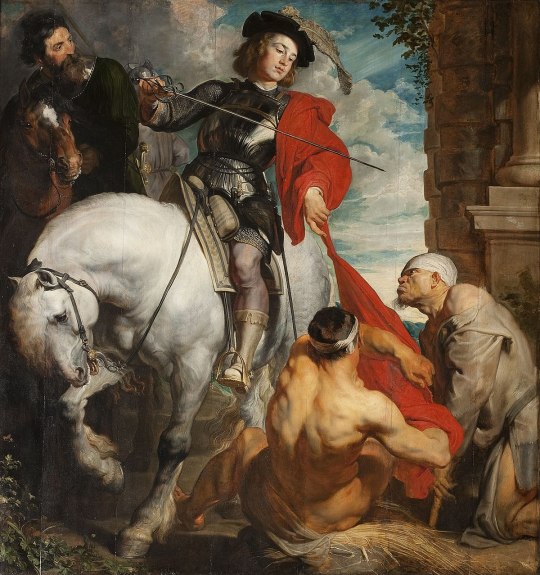
Anthony Van Dyck ~ "St. Martin Dividing His Cloak" (c.1618)
Happy Martinmas!
Today marks the feast day of St. Martin of Tours, who was bishop there from 371 CE until his death in 397 CE. He is the patron saint of many things, including: against poverty, against alcoholism, the poor, cavalry, Buenos Aires, quartermasters, wool-weavers, soldiers, and tailors, as well as wine growers, makers, and sellers. Whew! He must be very busy.
Keep reading for info about his life, a snitch goose, where the word 'chapel' came from, and how to tell what the weather will be like at Christmas.
His Life
Much of what we know about Martin comes from his hagiographer, Sulpicius Severus, who includes some 'artistic license' that is common in chronicles of the time, and therefore must be taken with a grain of salt.
Martin was born anywhere from 316-336 CE in Savaria, now Szombathely, Hungary. His father was a senior officer in the Roman Army, and as such was given land in northern Italy for his retirement. At the age of 10, Martin attended a Christian church against the wishes of his parents, and became interested in Christianity. Because of his father's status as a veteran, he was required to join the cavalry at 15. Dates surrounding his military service are shaky, but Severus states that, during his time stationed in Gaul, he was riding on horseback when he encountered a poor man with threadbare clothes. Having compassion on him, Martin used his sword to cut his own woolen cloak in two and gave the other half to the man. That night, Jesus Christ appeared to him in a dream, surrounded with angels and wearing half of the cloak. After this, Martin was baptised as a Christian. Though other miracles of his are recorded, this tale is the one most associated with Martin's life. It fits in with depictions of God or his angels in disguise as a beggar, traveller, &c., and is also a narrative found in many other religions and traditions. (Biblical examples include Abraham feeding the three angels in Genesis 18).
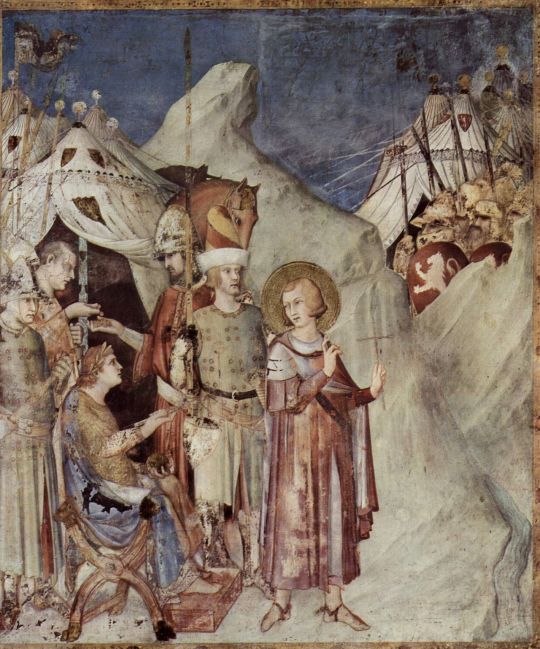
Martin dips from the army ~ fresco by Simone Martini (c.1320s)
With his new faith now firmly a part of his life, Martin decided to leave the army. Before a battle near modern-day Worms, Germany, Martin went before Emperor Julian and refused his salary, saying, "I am the soldier of Christ: it is not lawful for me to fight." They threw him in prison for this, but due to ye olde extenuating circumstances, he was released and discharged without further incident.
Martin made his way to modern-day Tours in France and declared himself a hermit, becoming a disciple and friend of Hilary of Tours. Because Christianity was Not OK™ in the Roman Empire, he and Hilary faced a lot of discrimination, including corporal punishment and exile. After converting his mother to Christianity and having numerous adventures, like living pretty much alone on an island, he and Hilary settled down in and around Poitiers, where Martin established Ligugé Abbey. It is the oldest known monastery in Europe! Martin made it his home base while he preached throughout western Gaul.

In 371 CE, the bishop of Tours died, and Martin was considered a good candidate for a successor. However, he liked living as a hermit and monk, and they resorted to tricking him into coming to Tours and then forced him to become the bishop. Legend holds that he tried to hide in a barn, but a honking goose gave him away. Hence he is the patron saint of geese, which I think is adorable. Martin proved true to his hermit ways, living very simply in huts with his monks. He established a rudimentary parish system, through which he visited different Christian communities and established monasteries. He was very determined in his efforts to convert local Pagans, as well as protect Christian institutions from unfriendly sects in the area, and in some cases he was successful. He died in 371 CE, already a venerated man. His popularity was ensured by his adoption by various French royals and by the Third Republic as a national symbol.
Martin has been portrayed by several famous artists, including Van Dyck, Peter Bruegel the Elder, and El Greco. He is usually portrayed on horseback, dividing his cloak for the poor man, though occasionally he can be seen riding a donkey. This references another story in his life about the time where he met the Devil and outwitted him. It also connects him to the image of Jesus riding a donkey into Jerusalem (recounted in Mark 1:1-11).
Martinmas and its Traditions
Martin lent his legacy to a host of English words and phrases, including those relating to the word 'chapel'. Temporary buildings that held the relic of his cloak (cappa in Latin) were referred to as cappella, and hence the word 'chapel' was born. A similar thing happened to the word 'chaplain', which derived from the word for the priest in charge of the cloak.
Though the Anglo-Saxon church did celebrate St. Martin to some extent, more references to Martinmas celebrations begin to crop up after Norman Conquest of 1066, when the Frenchman William the Conqueror invaded England. Supposedly, he promised to build an abbey dedicated to Martin if his invasion of England was successful. William was very likely familiar with the early Mediaeval association of the battle-hungry rulers of France with St. Martin, and was possibly responsible for his increased popularity in England.
In England and Scotland, and indeed through much of western Europe, Martinmas became a celebration marking the culmination of the harvest and the beginning of winter. From the late fourth century through the late Middle Ages, it also served a similar purpose to Mardi Gras/Carnivale: a period of fasting was ordained for the day after Martinmas through Christmas, so Martinmas was your last chance to stuff your face for a long time! (This period later became Advent, though with much laxer rules). As such, it was a time for feasting, celebration, bonfires, getting really drunk, and even events such as bull-running, as in Stamford, Lincolnshire. It was also a time for the end-of-harvest tasks, such as sowing winter wheat and slaughtering pigs and cattle. An old English saying goes, "His Martinmas will come, as it does to every hog", meaning, "they will get their comeuppance" or "everyone dies someday". Due to Martin's association with geese, some celebrated with a roast goose, but in Britain particularly it was also popular to eat salted pork or beef. For those not rich enough to have a goose, a duck or hen would also suffice. Other traditional fare included black pudding, haggis, and the first wine of the season.
On the business side of things, Martinmas served as a quarter day in Scotland and in parts England. A quarter day was one of four days on which major legal business was conducted. Servants and labourers would be hired or let go, rent was paid, contracts would begin or end, &c. Hiring fairs would be held for agricultural labourers seeking employment, and there would also be entertainment, food, trading, and other scenes of merriment. One of the most famous Martinmas fairs was at Nottingham in England, which lasted eight days.
Like many other English holidays, there is weather folklore associated with Martinmas. To have a warm fall and winter is to have a "St. Martin's Summer". If Martinmas proves an icy day, Christmas (or the rest of the winter) will be very warm. The rhyme puts it more pithily: "If the geese at Martin's Day stand on ice, they will walk in mud at Christmas".
If you stand at the back of the church and observe the congregation on Martinmas, those with a halo of light around their heads will not be alive by next Martinmas.

Interior of St. Martin-in-the-Fields, with a funky window!
The church of St. Martin-in-the-fields in Trafalgar Square in London is named after Martin. Many people commemorated there are associated with his anti-war sentiments -- these include Vera Brittain, a memoirist and pacifist; and Dick Sheppard, founder of the Peace Pledge Union. The church also supports houseless and vulnerably housed people.
The holiday gradually fell out of practice due to the English Reformation (when England split from the Catholic Church throughout the 1500s) and the Interregnum (Puritan republican government, 1649-1660). The observance of Armistice Day on the same day largely overshadowed the holiday in the UK, though many regions in Western Europe still take part in traditional festivities.
Martinmas is celebrated on 12 October in the Eastern Orthodox Church.
If You're Still Interested...
"The Life of St. Martin" by Sulpicius Severus himself! (pdf)
Pot Roast Martimas Beef Recipe by Chatsworth House
Sources
Historic UK
Wikipedia (Martin of Tours)
Wikipedia (St. Martin's Day)
Fisheaters.com
The Encyclopedia of Saints by Rosemary Ellen Guiley
"Medieval English "Martinmesse": The Archaeology of a Forgotten Festival" by Martin Walsh (via jstor)
#feast day series#feast day#martinmas#st martin#martin of tours#history#cultural history#english history#british history#saints day#folk history
8 notes
·
View notes
Text
11th November
Martinmas

Source: The Enchanted World, The Book of Christmas, Time-Life Books
Today is Martinmas or St Martin’s Day. Martin was a fourth century saint allocated to the traditional feast day of the Roman god of wine, a debauched character called Bacchus. This probably explains the copious amount of ale and wine traditionally drunk at Martinmas and the legend that Martin could cure drunkenness. He was also the patron saint of vintners. Martin also became associated with the transition from autumn to winter. At Martinmas, in commemoration of Martin’s alleged death after being gored by a bull, cattle were slaughtered in large numbers, which in actual fact was probably a holy connection with the necessary practice of laying down salted beef to help the peasantry survive the hard medieval winters. Martin was also supposed to have given away his cloak to a beggar shivering in the winter cold. This tradition is behind the belief that on his feast day, St Martin can be seen on horseback riding across the fields and meadows bringing the first snow of winter billowing out from the folds of his cloak.
Most Martinmas traditions have been replaced by the sombre commemoration of Armistice Day in the U.K., when wreaths are laid at the Cenotaph in memory of the British dead of the two World Wars and later conflicts. The Last Post is sounded at the ceremony and a two minute silence is observed from 11am. The Armistice that effectively ended the First World War was signed at the eleventh hour of the eleventh day of the eleventh month of 1918.
10 notes
·
View notes
Text
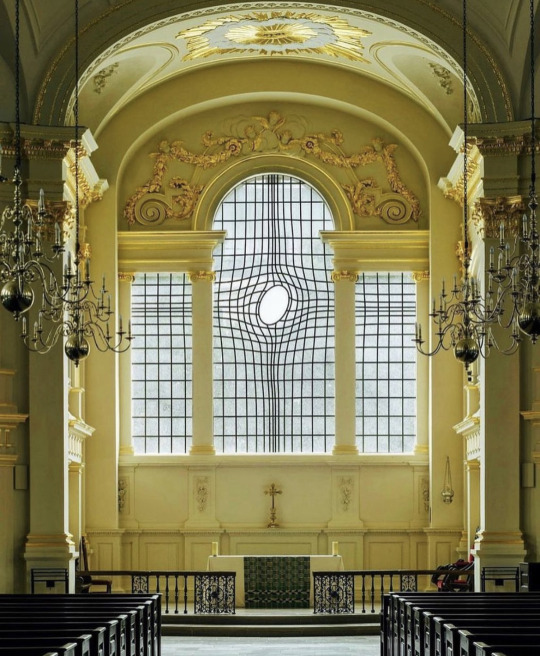
Londons Church of St. Martin
29 notes
·
View notes
Text

#st martin#st marteen#saint marteen#saint martin#island#photography#nature photography#nature#environment#water#ocean#sea#carribean
9 notes
·
View notes
Text
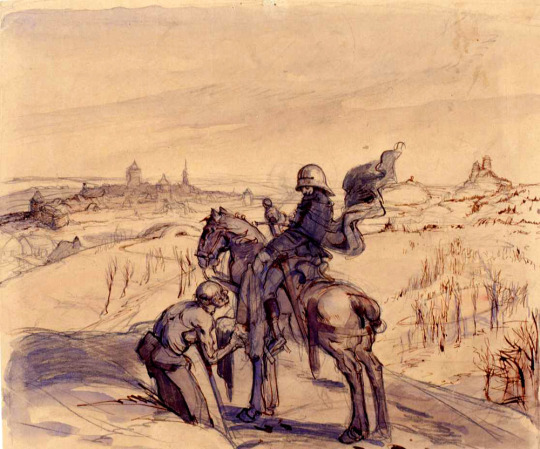
Saint Martin sharing his cloak by Léo Schnug
#léo schnug#art#saint martin#st martin#martin of tours#gaul#france#history#roman#knight#saints#chivalry#christian#christianity#beggar#europe#european#alsace#strasbourg
69 notes
·
View notes
Photo

St Martin
#canal st martin#st martin#paris#Paris apartment#parisian chic#parisian style#parisian vibe#paris mon amour
126 notes
·
View notes
Text

Can’t wait to see where 2024 will take me!
3 notes
·
View notes
Text

St Martin canal in Paris
French vintage postcard
#tarjeta#st martin#postkaart#paris#canal#sepia#st#historic#photo#postal#briefkaart#photography#vintage#ephemera#martin#ansichtskarte#old#postcard#french#postkarte#carte postale
4 notes
·
View notes
Text

i am not a particular devotee of St. Martin, but I had a special favor to ask, so I made a special offering for his feast day: wine, cheese, nuts, and homemade dulce de membrillo made from fallen quinces. the dulce de membrillo didn't come out the reddish color i prefer because the quinces people plant here don't have the right tannins required to make the flesh change color when cooked. anyway, wine and cheese for the wine saint (over matters related to wine) felt appropriate!
22 notes
·
View notes
Text
Roxy and her St Martin's lantern
youtube
Roxy is very proud of her lantern ✨

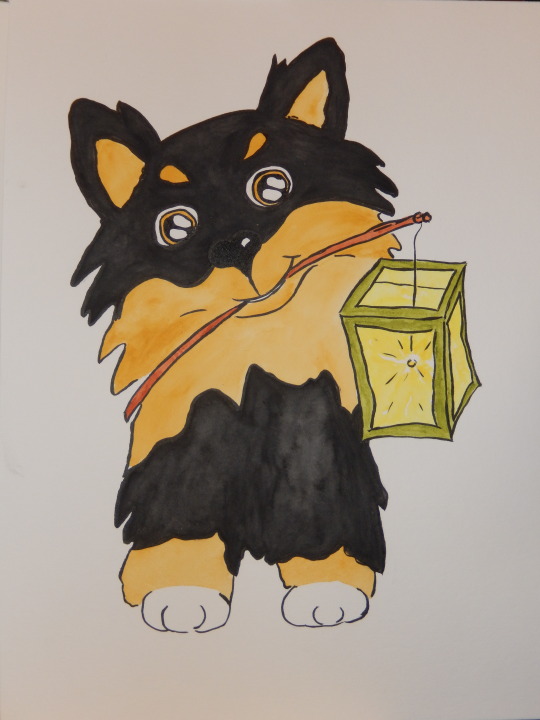
You can find out more about Roxy in my illustrated children's book :
"Ein kleiner Hund namens Roxy"
ISBN 978-3752625486
3 notes
·
View notes
Text

do you know saint martin?
2 notes
·
View notes